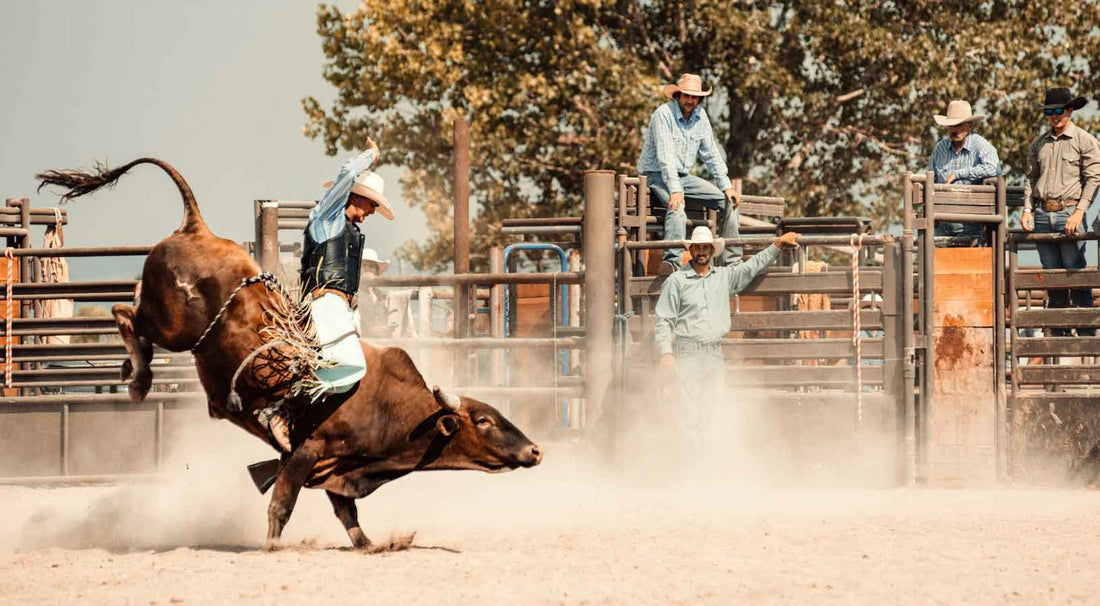It is officially rodeo season in Houston! Attending the rodeo offers a glimpse into the enduring legacy of cowboy heritage as a strong foundation of American culture. Rodeos originated in the late 1800s as a way for cowboys to showcase their riding and roping skills; today, these events showcasing competition and entertainment are one of the most popular sports in the United States. Rooted in a sense of identity and symbolism, preserving this unique Western tradition serves as a reminder of the values encompassing Western lifestyle while remaining relevant in modern society.
Currently, rodeos are a worldwide phenomenon, with nearly 5,000 Professional Rodeo Cowboy Association (PRCA) members competing year-round. People of all ages attend to witness incredible battles like bareback riding, steer wrestling, team roping, and bull riding, as well as music concerts. They participate in the thrill of carnival rides and livestock shows and taste delicious fried food.
How It All Started: The First Rodeo
Traced back to the mid-1800s, rodeo's early origins were casual games held among cattle operations in places like Deer Trade Colorado Territory. In these contests, the best riders competed against the wildest horses, and the ranchers' winners often received a new set of clothes as a prize.
The first recorded official rodeo contest occurred in Pecos, Texas in 1883. However, the exact birthplace of rodeo is a matter of debate, with other cities like Prescot, Arizona, and Pleasanton, Texas, claiming to have early rodeo events, too. The sport quickly gained popularity throughout the Southwest and Midwest states and eventually spread eastward.
By the late 1800s, the rodeo had evolved into a spectator event with established rules, admission tickets, and cash or practical items given to the winners as prizes. During the 1920s, talented riders emerged, and music became an integral part of the celebration. The festival's popularity extended beyond the borders of the United States, becoming an international affair, with places like England, Cuba, South America, and Africa hosting their own rodeo events.
In 1929, as celebrating the Western spirit started to grow, the regulation of rodeo came with the formation of organizations like the Rodeo Association of America. It sought to standardize rules, regulate the developing industry, and promote the sport on national and international levels. The Cowboys' Turtle Association, founded in 1936 and later renamed in 1945 as the Rodeo Cowboys Association, played a significant role in furthering the formality of rodeo.
In 1975, the Rodeo Cowboys Association was rebranded as the Professional Rodeo Cowboys Association (PRCA), solidifying its status as the largest rodeo organization in the world. The PRCA oversees events like the National Finals Rodeo (NFR) held annually in Las Vegas, Nevada, often called the "Super Bowl of Rodeo."
Bull riding, often said to be “the most dangerous eight seconds in sports,” was introduced to the rodeo in the 1930s in Columbia, Mississippi. It quickly became one of the most thrilling events in rodeo competitions.
Traditionally, belt buckles were awarded to rodeo champions as trophies, symbolizing honor and victory. Over time, these pieces have become more than just symbols; they embody Western rodeo culture's rich history and traditions. Today, belt buckles are intricate works of art featuring personalized engravings unique to each champion, adding prestige to the significance of winning a rodeo championship.
How It's Going: From the Pasture to the Arena
Rodeos continue to play a crucial role in celebrating the sport and the deep-rooted agriculture and ranching lifestyle that are central to many communities, particularly in Texas. The Houston Livestock Show and Rodeo™ stands out as one of the premier events in the world of rodeo, agriculture, and entertainment. Held at the NRG stadium, it is one of the largest rodeo events in the world and draws millions of visitors from around the globe.
Thirty-five thousand volunteers dedicate their time and energy to ensure its success, reflecting the strong sense of community and pride associated with the rodeo tradition. With its extensive lineup of events, including rodeo competitions, livestock shows, concerts, carnival rides, and educational exhibits, the Houston Livestock Show and Rodeo™ offers something for everyone.
As it approaches its 92nd anniversary, the rodeo continues its tradition of giving back and supporting educational initiatives. One of the most impactful ways the rodeo contributes to the community is through its generous scholarship program. Since 1932, the rodeo has donated $500 million, with $22 million being contributed in 2023 alone. These funds support students pursuing higher education and serve as a life-changing platform for kids by participating in the art program.
Other rodeos that showcase the enduring popularity of the sport of rodeo and the ability to bring communities together are the Cheyenne Frontier Days in Wyoming, La Fiesta de los Vaqueros in Tucson, Arizona, and the Calgary Stampede in Alberta, Canada, each offering unique experiences and traditions. Cheyenne began in 1897 and holds a special place in rodeo history because, for many years, winners of that rodeo were considered the world’s best. La Fiesta de los Vaqueros is another iconic rodeo. It is a week-long affair recognized as the longest non-motorized horse-drawn parade in the world. The Calgary Stampede stands out as a ten-day massive western heritage celebration in Canada, proudly claiming to be the world’s largest outdoor rodeo.
It's fascinating to see how rodeo has adapted over time, holding immense impact in North America, not only for their deep historical roots but also for their evolution into entertainment, attracting visitors who contribute to the economic vitality of the communities hosting them. From humble beginnings as informal competitions to becoming grand spectacles that provide opportunities for local businesses to thrive, rodeos indeed hold a special place in American and global civilization, reflecting the spirit of the Wild West as an integral part of our cultural fabric.







